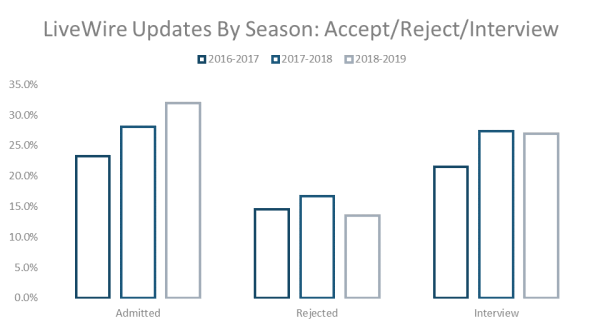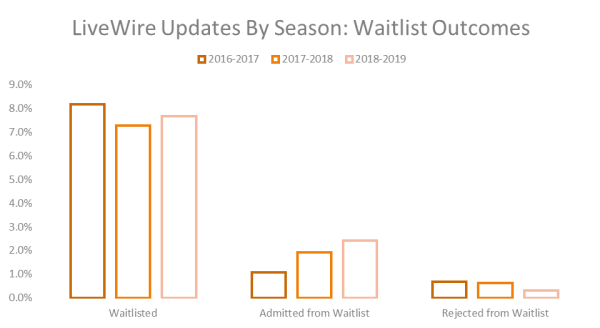Declining application volume for full-time, two-year MBA programs was a trend of significant interest—and some concern—among graduate management education stakeholders during the 2017-2018 academic year. With another admissions season drawing to a close, we wondered what data from Clear Admit’s LiveWire tool might be able to tell us about application volume for 2018-2019.
LiveWire allows MBA applicants to post updates about admissions process milestones in real time, sharing news about school-specific outcomes like interview invitations, acceptances, waitlist decisions, and rejections with their fellow prospective students in the Clear Admit community. While each individual update is immensely valuable to applicants who are wondering when and how they might hear from their target programs (has their first-choice program been quiet this week, or are decisions going out? Should they be refreshing their email, or hoping for a call?), looking at LiveWire activity in aggregate can provide a window into larger trends and patterns.
Context for Interpreting LiveWire Data
Before we begin, it’s important to note that LiveWire results aren’t representative of the universe of MBA applicants and admissions outcomes. The first reason is that as a general rule, people are more eager to share positive news than negative news. As a result, more candidates post to LiveWire about acceptances than about less favorable outcomes, whereas we know that selective MBA programs in fact reject many more applicants than they admit.
The second reason is that Clear Admit community members represent a fairly savvy and elite segment of the MBA applicant pool; the average undergraduate GPA for LiveWire posters is 3.53 and their average GMAT score is 722. We’ve found that this translates to users posting updates to LiveWire who may be more successful in their admissions processes than the average business school applicant.
That said, these user characteristics and information-sharing biases are factors that hold steady over time. This means that year-to-year differences in LiveWire data are likely to reflect meaningful trends in the landscape of MBA admissions.
LiveWire Results and MBA Application Volume Implications
So what patterns do we see in this year’s LiveWire data as compared to last year’s, and what can we infer about application volume?
We segmented LiveWire updates by admissions season, looking at results submitted between September 1st and June 3rd of the three academic years for which LiveWire data was available. We then calculated the percentage of updates that covered Acceptances, Rejections, and Interview Invitations during each of the three admissions seasons.

Looking at the percentage of LiveWire updates reflecting acceptances over the past three seasons, we see a clear upward trend. This suggests that business schools may be admitting a larger percentage of a more limited applicant pool in order to fill a fixed number of seats in their incoming classes.
It’s also striking that interview invitations account for roughly the same percentage of LiveWire updates in 2017-2018 and 2018-2019. This suggests that admissions committees are meeting with similar numbers of candidates (and that LiveWire users haven’t changed their behavior in terms of the kind of news they share via the tool), which supports the interpretation that the increase in acceptance-related updates reflects a larger MBA admissions trend.
The percentage of LiveWire posts comprising waitlist-related updates during this same time frame reinforces this conclusion.

We don’t see much movement in the percentage of applicants reporting waitlist decisions via LiveWire, suggesting that schools haven’t made any major changes in who or how many candidates they place on hold in a given year. We do, however, see slightly more LiveWire users reporting acceptances from the waitlist and fewer reporting waitlist rejections, which again would seem to indicate that schools may be admitting more waitlisted candidates to fill their classes than they have in previous years.
Explaining the Trend and Looking Ahead
In explaining the decline in application volume for 2017-2018, Graduate management education stakeholders have identified a number of reasons that fewer people might be applying to two-year, full-time MBA programs, particularly in the U.S. These include:
- a strong economy and low unemployment
- a somewhat chilly immigration climate
- the rising popularity of specialized one-year Master’s programs
- the increasing presence of full-time MBA programs in Asia and Europe.
Given that each of these factors has persisted through the most recent admissions season, it’s no surprise that the trend of fewer MBA applications appears to have held for 2018-2019.
We’re eager to see how our data maps on to the results that schools will be reporting in the coming months, and what application volume will look like for 2019-2020. In the meantime, stay tuned for additional updates and MBA admissions insights based on Clear Admit data.









